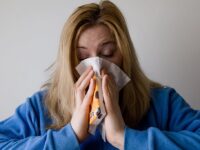The college student population is one of the most susceptible to getting sick. Students go to lectures with 120 other students squeezed next to each other, eat in the dining hall where everyone else has their mouths open, and live in the same building as 200 other students. With shared quarters and all of the constant social interaction, it makes sense how easily students are able to fall ill. Students are not the only ones living on campus: Germs are everywhere.
Influenza, or the flu, is a contagious respiratory illness that can cause mild to severe illness. Common symptoms include fever, chills, cough, sore throat, stuffy nose, body aches, headaches, fatigue, and possibly diarrhea. The flu should not be confused with the common cold, as some cases can lead to hospitalization and even death. According to the CDC, estimates show that influenza has resulted in between 9 to 45 million illnesses, 140,000 to 810,000 hospitalizations, and 12,000 to 61,000 deaths per year since 2010.
An infected person can spread the flu to others who are less than six feet away. The primary method of transmission, or passing the virus to another, is through droplets that are made when people exhale. These respiratory droplets can be visibly large, like saliva, or small — meaning they dry quickly and remain airborne for minutes up to hours. When someone is near an individual with influenza, they can end up inhaling droplets or have droplets land in their mouths or noses. Another method of transmission is through touching surfaces that have the virus on them and then touching one’s mouth, nose, or eyes.
Students should not be commended for going to class sick; rather, they should be encouraged to take a break.
So why should students think twice about going to class when they are not feeling good? When someone is infected with the flu, they are the most contagious in the first three to four days. Symptoms can begin to show about one to four days after the virus enters the body. Therefore, a student, who may otherwise feel fine, can spread the virus to others one day before symptoms develop and up to five to seven days after falling ill. In some cases, students can have the flu and never show any symptoms, but they are still capable of transmitting the virus to their classmates.
What should students do in order to lower their risks of being infected? First, students should get the annual influenza vaccination. The vaccination has been shown to reduce the risk of getting the virus as well as reducing the severity of symptoms if one is infected. Second, students should follow healthy behaviors. Another reason why students are hit so hard by viruses is due to their weakened immune systems that result from unhealthy habits and behavior. Sleep deprivation puts one’s body at a higher risk for infection because it compromises the immune system’s ability to produce helpful immune cells. A poor diet as well as emotional and physical stress can also weaken the body, making it more vulnerable to illness. Students must realize that nothing, not even grades, comes before their health.
The seasonal flu arrives every year, and it is not picky when it comes to choosing its victims.
Now that instructors and students have seen the severe effects of COVID-19, it is sensible to believe that instructors will be more lenient with illness-related absences and that students will think twice about going to class when sick. The flu should not be taken lightly, especially on a college campus. If a student goes to class just to cough and sneeze for an hour and 20 minutes, no one will feel comfortable. Students should not be commended for going to class sick; rather, they should be encouraged to take a break. By going to class sick, not only are students putting the health of others at risk, but they are also worsening their own health because they are not giving themselves a chance to recover.
The seasonal flu arrives every year, and it is not picky when it comes to choosing its victims. Take the necessary precautions and follow behaviors recommended by reliable scientists and health professionals. Just because college students are stuck in an environment where it is easy to get sick does not mean students should simply accept that they will get sick no matter what they do. Students must be responsible and consider the health and safety of themselves and their fellow classmates.

